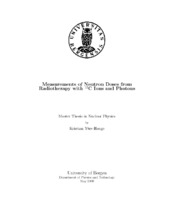Measurement of Neutron Doses from Radiotherapy with 12C Ions and Photons
Master thesis
Permanent lenke
https://hdl.handle.net/1956/3422Utgivelsesdato
2009-05-21Metadata
Vis full innførselSamlinger
Sammendrag
The overall objective of this thesis has been to investigate the neutron doses from radiotherapy with photons and ions. The advantages of proton and ion therapy, compared to the use of photons were also examined. During cancer radiotherapy, patients receive undesired dose from neutrons produced in collimators and in the patient. Measurements with bubble detectors were performed to investigate neutron doses from radiotherapy, using 200 MeV/u 12C ions, at GSI-Darmstadt in Germany, and a 15 MeV photon beam at Haukeland University Hospital in Bergen. Neutron energy spectra were also obtained from the photon beam measurements. The bubble detectors were tested in a series of measurements to investigate the uncertainties in the measurements of neutron dose. The principles of neutron production were investigated both for radiotherapy with photons and carbon ions. During photon radiotherapy, neutrons are produced through photonuclear reactions. The majority of the neutrons are produced in the target and the collimators in the linear accelerator, but neutrons can also be produced in the patient body if the photon energy is sufficiently high. The carbon therapy facility at GSI do not use collimators, but neutrons are still produced through nuclear interactions between the primary carbon ions and nuclei in the patient. Neutron sensitive thermoluminescence detectors and a uranium-based fission counter have also been tested as neutron detectors in this study. Only preliminary tests have been performed with these detectors, and neutron doses have not been obtained with these detectors in this work. The total neutron dose from radiotherapy with photons was found to be in the order of mSv per Gray. The spectra obtained indicate a neutron fluence in the order of 10^7 n.cm^(-2) per Gray with a peak in the neutron energy around 1 MeV for measurements without a phantom, while compared to this, the spectra for in-phantom measurements are shifted downwards in energy. Concerning the spectra obtained, the results indicate that the uncertainties are relatively large, making it difficult to reach conclusive information. Changes in response of the bubble detectors due to temperature variations in the measuring environment has been one of the factors which increased the uncertainties in the measurements. Changes in response for the bubble detectors after repeated use have also had an influence on the results. Future measurements should be made using the knowledge gained in this work in order to reduce uncertainties. The bubble detectors' response to neutrons of energies above 20 MeV was not established during these measurements, therefore, no conclusion has been drawn concerning the equivalent neutron doses from carbon radiotherapy.
Utgiver
The University of BergenOpphavsrett
The authorCopyright the author. All rights reserved
